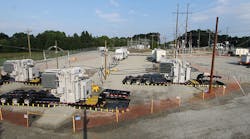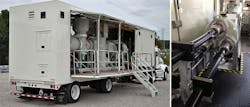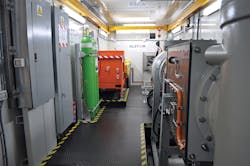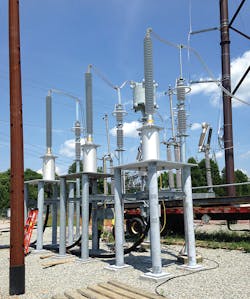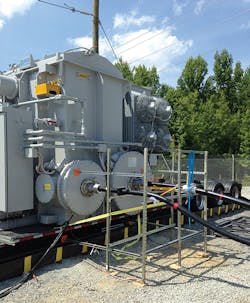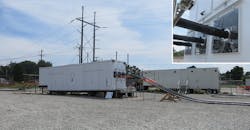When it was time to rebuild a portion of the 115-kV radial Bremo-Cartersville transmission line in Cumberland and Fluvanna counties, Virginia, U.S., Dominion Energy immediately equated the rugged terrain — specifically a steep bluff — with a costly temporary line, right-of-way access challenges and safety concerns for its crews. However, Dominion Energy is no stranger to innovation, especially when it comes to serving more than 2.6 million customer accounts in Virginia and northeastern North Carolina, U.S. The utility is accustomed to thinking creatively about electric transmission projects because of the diverse conditions found in the region: coastal areas, mountains, rural communities and densely populated cities.
After considering the options for the Bremo-Cartersville line, Dominion Energy decided to use a 230/115-kV mobile substation to feed the load using a parallel 230-kV transmission line at the adjacent Cartersville substation. Coined the Cartersville Mobile Substation Installation, this solution was the first 230/115-kV mobile installation of its kind in North America. This project was different because it was a transmission-to-transmission application and featured self-contained gas-insulated substation (GIS) bays. This was the first time 230-kV underground cable had been used for temporary work. The rebuild project also involved underground cable connections: GIS to GIS and GIS to air-insulated bus (AIB).
It took four months to set up the Cartersville Mobile Substation Installation. The scope included grading work as well as the installation of gravel, a ground grid, a security fence and five mobile trailers on a 3-acre (1.2-hectare) parcel in Cumberland County. The equipment included a 230-kV mobile switch, a 245-kV mobile GIS bay, three single-phase 230/115-kV mobile transformers, a 138-kV mobile GIS bay, a 115-kV mobile switch, and 138-kV and 230-kV underground cables. The mobile substation installation was energized and de-energized exactly as planned. No safety or human performance incidents occurred, thanks to detailed work plans.
Emergency Preparedness
Dominion Energy purchased the mobile substation as part of its resiliency strategy for responding to cyber-attacks, physical breaches, extreme weather and other such events. With hurricanes posing a real threat to the area, the mobile substation is a valuable asset. It allows the utility to re-establish service within seven days of an incident inside existing substations. Depending on the circumstances, without the mobile substation, the complete loss of a substation transmission transformer could take two months or more from which to recover.
The Bremo-Cartersville rebuild project presented the perfect opportunity for using the mobile substation. The project saw the installation of the mobile substation adjacent to the Cartersville substation. It provided the opportunity to vet procedures and associated checklists, as well as to test equipment.
Viability and Reliability
The Cartersville Mobile Substation Installation carried the Bremo-Cartersville load 24 hours a day, seven days a week from Aug. 2, 2016, to Dec. 2, 2016. The success of the installation demonstrates the mobile substation’s viability for unplanned restoration efforts and future transmission construction projects. One benefit of the mobile substation is its ability to integrate with the current line protection, providing the same reliability in a temporary connection as a permanent one.
The mobile substation also is separable and can be used individually. For example, a breaker failure or loss of a three-phase transformer can be resolved in 48 hours to 72 hours using only the breakers or single-phase transformers of the mobile fleet.
The underground cable links enable a large array of connections to be made, minimizing the need for disruptions to the surrounding environment as well as maximizing safety to personnel and the public. The underground cable links greatly reduce the installation time.
While Dominion Energy is used to working with GIS breakers in standard substation configurations, the GIS breakers in the mobile configuration are mounted inside self-contained trailers. The breakers can be used for bypassing transmission switches while eliminating line outages for maintenance or replacement.
A Team Effort
Tremendous coordination occurred across the electric transmission organization. During the Cartersville Mobile Substation Installation, biweekly meetings turned into weekly meetings. The installation was non-standard, and field engineering was ongoing throughout the duration of the project.
A 19-acre (7.6-hectare) parcel was rented from a local property owner, of which 3 acres were used for the mobile substation. Located in Cumberland County, the parcel was adjacent to Dominion Energy’s Cartersville substation and another substation owned by Central Virginia Electric Cooperative (CVEC). After the mobile substation was dismantled, the parcel was restored to its original condition.
Dominion Energy met with Cumberland County early on to discuss the project. Because the substation was designed and built to be temporary, the county did not require a permit. However, the site was included in the state storm water permit acquired for the overall line rebuild project.
Dominion Energy worked with seven suppliers from three continents: Mitsubishi Electric, Alstom (now GE), Pfisterer, Southwire, Okonite, HICO and Trail King Industries. Because the equipment was non-standard, it was difficult to find willing suppliers capable of completing the technical engineering designs and then warranting their work. Simply put, this posed a unique challenge to suppliers.
Dominion Energy also worked with three contractors to support the mobile substation installation.
Leading-Edge Technology
The concept of Dominion Energy’s mobile substation was based on tried-and-true transmission substation knowledge. However, engineers applied the technology in a new and innovative way to create a mobile substation that is best in industry. From the beginning, Dominion Energy had a unique design for its mobile substation in mind. Engineers attended industry forums and conferences to learn more about the technology available on the market. They were thinking outside the box and looking for suppliers to do the same with their engineering concepts.
Dominion Energy opted for a plug-and-play concept while applying underground cables and special socket connections manufactured by Pfisterer. This approach reduces the amount of time it takes to install mobile substations, while not requiring the typical overhead support structures and added installation spacing.
The cables consist of 230-kV cross-linked polyethylene (XLPE) insulation manufactured by Southwire and 138-kV ethylene propylene rubber (EPR) insulation manufactured by Okonite. The cables are installed along the ground and plugged directly into the mobile GIS bays and transformers. Pfisterer helped to educate and assist engineers and contractors with the cable terminations as well as the installation.
The 138-kV GIS bay was manufactured by Alstom (now GE), shipped to Spain for integration into the mobile trailer, fully tested and then shipped to the U.S. The 230-kV GIS switchgear was manufactured by Mitsubishi Electric and then integrated into the mobile trailer in the U.S. by AZZ Manufacturing. Road tests were conducted on the unit at the Honda test track in the U.S.
Each mobile GIS bay consists of one gas circuit breaker, line-side and load-side disconnect and ground switches, a potential transformer that can be used for station service, gas-handling equipment, station batteries with a charger, and protection and control relays.
One of the innovations associated with this project was the ability to perform a high-voltage withstand test on the 138-kV GIS bay by backfeeding through the voltage transformer on the switchgear, using test equipment and reactor modules provided by OMICRON. This presented a significant time and cost savings over the normal testing method, which would have required transporting a test transformer to the site.
The three 230/115-kV single-phase transformers were manufactured by HICO and then integrated into the mobile trailer. HICO optimized the transformer design to meet all the technical requirements and arrived at a 195-MVA loading capacity. The specified high-voltage-rated Pfisterer socket terminations were applied to accept the underground cable connections. HICO worked with Trail King Industries to develop and manufacture low-boy trailers around critical weight distribution requirements and tight tolerance interfaces while also meeting all the required roadway transport limitations.
Lessons Learned
The Cartersville Mobile Substation Installation was not without challenges. The biggest challenge was designing roadworthy trailer-mounted mobile substation equipment that met all the required technical and reliability requirements. The final products had to be eligible for Virginia’s and North Carolina’s Department of Transportation blanket highway permits, which required close attention to ensure the trailer weights, heights, widths and lengths were well within the specified limits. This was extra challenging with the transformers and associated trailers, as they were the largest pieces of equipment. The cable reels had to be designed with removable flanges to make them more easily transportable.
The 3-acre parcel selected for the mobile substation had a slope that required extensive grading to avoid issues with water drainage and oil containment. It was important for the transformers to be installed on level grade with minimal tilt.
The maneuverability of the cables was challenging, as well. The 138-kV EPR cables are more flexible than the 230-kV XLPE cables, and the XLPE cables are much heavier. Since the cables had to be recoiled and used for future mobile substation installations, the cables were uncoiled carefully. Once the cables were down, other items within the substation could not be moved for risk the cables would be damaged. As part of the demobilization plan, a special reel stand was ordered to roll up the 230-kV cable and transport it to a storage facility.
Future Applications
The Cartersville Mobile Substation Installation was a success. By choosing the mobile substation instead of a temporary overhead line for the Bremo-Cartersville rebuild project, at least six months of construction was avoided. In addition, the one-time cost of the mobile substation was approximately 30% of the total cost of a temporary overhead line. This savings accounts for almost 40% of the total cost of the equipment. The equipment will pay for itself with one more application, planned or unplanned.
While it may not be ideal for every project, the mobile substation does have a permanent place in Dominion Energy’s tool kit. ♦
Bobby Rich is an engineer in Dominion Energy’s electric transmission organization. He earned a BS degree in nuclear science from Thomas Edison State University while serving in the U.S. Navy. He earned a BSEE degree and a BS degree in physics from Virginia Commonwealth University before joining Dominion Energy in 2013. He works in the field operations engineering support group and is responsible for managing all transmission-level mobile gas-insulated substation and temporary 230-kV underground cable installations.
Angelita Gardner-Kittrell is a project manager in Dominion Energy’s electric transmission organization. She holds a BSEE degree from North Carolina A&T State University. She joined Dominion Energy in 1993 and currently manages a diverse portfolio of transmission and distribution projects in the transmission line engineering group.
